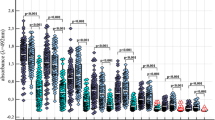Summary
PyelonephritogenicEscherichia coli isolates were found to be equal in their ability to adhere to uroepithelial cells and to cause agglutination specific for human erythrocytes. This adhesive capacity was not affected byD-mannose and was found to be mediated by a new class ofE. coli fimbriae named P-fimbriae. Using human erythrocytes of different blood groups, we found the receptor molecules for P-fimbriae to be associated with the P blood group antigens, i. e. glycosphingolipids corresponding to the P blood group antigens P, P1 and Pk. By agglutination studies of erythrocytes with various set-ups of these antigens as well as by inhibition studies using synthetic saccharide derivatives and by coating non-agglutinable erythrocytes with a synthetic glycolipid, the minimal receptor structure was identified as the α-D-Galp-(1–4)-β-D-Galp moiety of the carbohydrate portion of these glycosphingolipids. Similar experiments on isolated uroepithelial cells proved that these glycosphingolipids also constitute the receptors in the urinary tract.
Zusammenfassung
PyelonephritogeneEscherichia coli-Isolate besitzen gleichermaßen die Fähigkeit, an uroepithelialen Zellen zu haften und menschliche Erythrozyten spezifisch zu agglutinieren. Die Haftfähigkeit wird durch D-Mannose nicht beeinflußt; sie wird durch eine neuentdeckte Klasse vonE. coli-Fimbrien, sogenannten P-Fimbrien, vermittelt. Durch Testung von menschlichen Erythrozyten verschiedener Blutgruppen zeigte sich, daß die Rezeptormoleküle für die P-Fimbrien mit den Antigenen der Blutgruppe P assoziiert sind, Glykosphingolipiden, die den Antigenen P, P1 und Pk der Blutgruppe P entsprechen. Agglutinationstests mit Erythrozyten, die diese Antigene in unterschiedlicher Konstellation besitzen, Hemmtests mit synthetischen Saccharidderivaten sowie Beladen nicht agglutinierbarer Erythrozyten mit einem synthetischen Glykolipid führten zur Identifizierung der minimalen Rezeptorstruktur als α-D-Galp-(1–4)-β-D-Galp-Verbindung des Kohlenhydratanteils dieser Glykosphingolipide. Ähnliche Experimente an isolierten uroepithelialen Zellen bewiesen, daß diese Glykosphingolipide auch die Rezeptoren des Harntrakts darstellen.
Similar content being viewed by others
Literature
Svanborg Edén, C., Hanson, L. Å., Jodal, U., Lindberg, U., Sohl-Åkerlund, A. Variable adherence to normal human urinary tract epithelial cells ofEscherichia coli strains associated with various froms of urinary tract infections. Lancet II (1976) 490–492.
Svanborg Edén, C., Eriksson, B., Hanson L. Å., Jodal, U., Kaijser, B., Lidin Janson, G., Lindberg, U., Olling, S. Adhesion to normal human uroepithelial cells ofEscherichia coli from children with various forms of urinary tract infection. J. Pediatr. 93 (1978) 398–403.
Stamey, T. A., Sexton, C. C. The role of vaginal colonization withEnterobacteriaceae in recurrent urinary infections. J. Urol. 113 (1975) 214–217.
Källenius, G., Winberg, J. Bacterial adherence to periurethral epithelial cells in girls prone to urinary-tract infections. Lancet II (1978) 540–543.
Källenius, G., Möllby, R. Adhesion ofEscherichia coli to human periurethral cells correlated to mannose-resistant agglutination of human erythrocytes. FEMS Microbiol. Lett. 5 (1979) 295–299.
Källenius, G., Möllby, R., Winberg, J. In vitro adhesion of uropathogenicEscherichia coli to human periurethral cells. Infect. Immun. 28 (1980) 972–980.
Duguid, J. P., Gillies, R. R. Fimbriae and adhesive properties in dysentery bacilli. J. Pathol. Bacteriol. 74 (1957) 397–411.
Brinton, C. C. Jr. Non-flagellar appendages of bacteria. Nature 183 (1959) 782–786.
Duguid, J. P. The function of bacterial fimbriae. Arch. Immunol. Ther. Exp. (Warsz.) 16 (1968) 173–188.
Korhonen, T. K., Edén, S., Svanborg Edén, C. Binding of purifiedEscherichia coli pili to human urinary tract epithelial cells. FEMS Microbiol. Lett. 7 (1980) 237–240.
Källenius, G., Möllby, R., Svenson, S. B., Winberg, J., Lundblad, A., Svensson, S., Cedergren, B. The Pk antigen as receptor for the haemagglutinin of pyelonephriticEscherichia coli. FEMS Microbiol. Lett. 7 (1980) 297–302.
Race, R., Sanger, R. Blood groups in man. 6th ed. Blackwell, Oxford 1975.
Naiki, M., Marcus, D. M. An immunochemical study of the human blood group P1, P and Pk glycosphingolipid antigens. Biochemistry 14 (1975) 4837–4841.
Källenius, G., Möllby, R., Svenson, S. B., Winberg, J., Hultberg, H. Identification of a carbohydrate receptor recognized by uropathogenicEscherichia coli. Infection 8 Suppl. 3 (1980) S 288-S 295.
Källenius, G., Svenson, S. B., Möllby, R., Cedergren, B., Hultberg, H., Winberg, J. Structure of carbohydrate part of receptor on human uroepithelial cells for pyelonephritogenicE. coli. Lancet II (1981) 604–606.
Källenius, G., Svenson, S. B., Möllby, R., Korhonen, T. K., Winberg J., Cedergren, B., Helin, I., Hultberg, H. Carbohydrate receptor structures recognized by uropathogenicE. coli. Scand. J. Infect. Dis. Suppl. 33 (1982) 52–60.
Källenius, G., Möllby, R., Svenson, S. B., Helin I., Hultberg, H., Cedergren, B., Winberg, J. Occurrence of P-fimbriatedEscherichia coli in urinary tract infections. Lancet II (1981) 1369–1372.
Väisänen, V., Elo, J., Siitonen, A., Svanborg Edén, C., Källenius, G., Svenson, S. B., Hultberg, H., Mäkelä, H., Korhonen, T. K. Mannose-resistant haemagglutination and P antigen recognition are characteristic ofEscherichia coli causing primary pyelonephritis. Lancet II (1981) 1366–1369.
Leffler, H., Svanborg Edén, C. Chemical identification of a glycosphingolipid receptor forE. coli attaching to human urinary tract epithelial cells and agglutinating human erythrocytes. FEMS Microbiol. Lett. 8 (1980) 127–134.
Marcus, D. M., Naiki, M., Kundu, S. K. Abnormalities in the glycosphingolipid content of human pk and\(\bar p\) erythrocytes. Proc. Natl. Acad. Sci. 73 (1976) 3263–3267.
Makita, A., Yamakawa, T. Biochemistry of organ glycolipids. III. The structures of human kidney cerebroside sulfuric ester, ceramide dihexoside and ceramide trihexoside. J. Biochem. 55 (1964) 365–370.
Mårtenson, E. On the neutral glycolipids of human kidney. Acta Chem. Scand. 17 (1963) 2356–2358.
Korhonen, T., Väisänen, V., Saxén, H., Hultberg, H., Svenson, S. B. P-antigen-recognizing fimbriae from human uropathogenicEscherichia coli strains. Infect. Immun. 37 (1982) 286–291.
Källenius, G., Svenson, S. B., Hultberg, H., Möllby, R., Winberg, J., Roberts, J. A. P-fimbriae of pyelonephritogenicEscherichia coli: Significance for reflux and renal scarring — a hypothesis. Infection 11 (1983) 73–76.
Möllby, R., Källenius, G., Korhonen, T. K., Winberg, J., Svenson, S. B. P-fimbriae of pylonephritogenicEscherichia coli: Their detection in a clinical material by a rapid receptor-specific agglutination test. Infection 11 (1983) 68–72.
Author information
Authors and Affiliations
Rights and permissions
About this article
Cite this article
Svenson, S.B., Källenius, G., Möllby, R. et al. P-fimbriae of pyelonephritogenic Escherichia coli: Identification and chemical characterization of receptors. Infection 11, 61–67 (1983). https://doi.org/10.1007/BF01651362
Issue Date:
DOI: https://doi.org/10.1007/BF01651362




